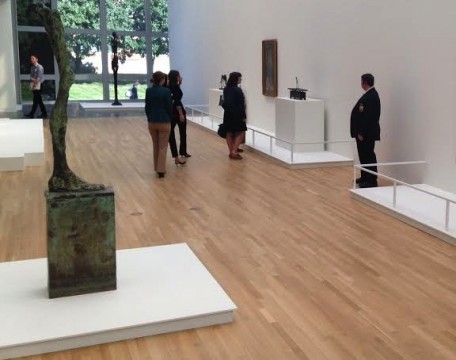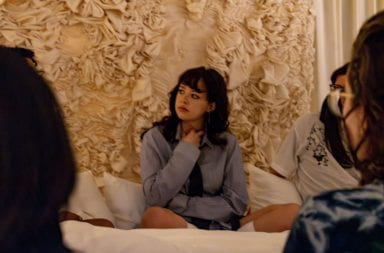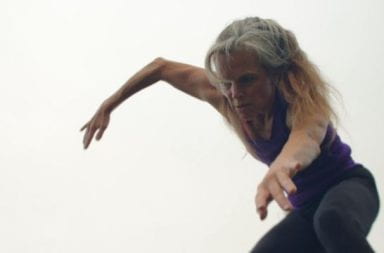
Visitors at the Wexner Center for the Arts look at Giacometti’s work while a security guard looks on.
Credit: Daniel Bendtsen / Asst. arts editor
There’s a reason this section is called “arts and entertainment.” The two have a lot of overlap — in an ideal world, they’d be synonymous: aesthetic and amusement intertwined into one.
Too often, the “fine arts” (e.g. ballet, sculpture) fail to entertain the masses. For some, art museums can seem to be full of some elitist snobbery, where the phonies go to become sophisticates.
That was a stigma curator Robert Storr was hoping to avoid when he worked on the Wexner Center for the Arts’ new gallery, “Transfigurations.” The collection comes from Les and Abigail Wexner’s personal collection and features the work of Pablo Picasso, Jean Dubuffet and Alberto Giacometti, among others. It’s a big deal for the center, and, as Storr said, “the best art should be seen by the most people.”
The populace, he said, is not alienated by art, but by what people say about art. Students in middle America usually “see art on screens or pages,” he said, and so he hopes the exhibition will give visitors a personal relationship with the works.
That is an admirable and wholly appropriate goal.
It’s only a shame, then, that the Wex hasn’t fostered an atmosphere conducive to make the most of the art.
Like going to the zoo or a stroll atop the Grand Canyon, a visit to the Wex’s galleries should be fun and thrilling, as well as cerebrally stimulating.
Unfortunately, all the fun goes out the window when you walk in the door. The Wex’s galleries have all the inviting charm of going through airport security.
There’s a cop at the entrance and another one inside. There are guards standing sentinel as though they’re Secret Service — and in case you didn’t figure out what they’re there for, the word “security” in big block letters on their backs drives home this point: Don’t you dare touch anything!
There are railings around the perimeter of the floor to keep visitors a good 3 feet from the paintings — which is a damn shame considering the painterly nature of much of the Wexners’ collection. For as much as people like to rant and rave about the childlike approach to the human figure from Picasso and Dubuffet, these works are great in part because of how texturally compelling they are.
There are works here of gouache, charcoal, pastel and bronze.
The oil paint on Willem de Koonings’ “Pink Lady” is cracked and shimmering; DuBuffet’s grotesque portraits are layered with tar and sand; the silhouettes of Giacometti’s sculptures are serrated and rough like an ominous shadow from a dream.
Part of the awesomeness of DuBuffet’s “Paris – Montparnasse” is the chaotic world of a city street it depicts, a depiction so strongly helped by the equally chaotic globs of paint plastered on the piece.
These works are strange and often absurd depictions of the world — brilliant, too, in their ability to show reality in a novel way it is clearly not.
But even more bizarre is to put them in an environment that turns an experience of the absurd into a sedated study session.
During one of my recent visits to “Transfigurations,” a man’s phone started ringing and he got a lengthy stare down from the two guards in the room until he was able to turn it off.
How dare he? He broke one of the “rules” on the lengthy list detailing the gallery’s “etiquette.” Didn’t he notice the dozen signs saying “no cell phone usage” lining the galleries?
Whether intentional or not, the atmosphere creates the impression that this is a place for silence. Whenever I’ve been in with a friend and our conversation about a painting rose above a whisper, the guards turned into prudish librarians and gave us a stern look as though our behavior had broken a carefully-cultivated solemnity.
There’s no problem with pondering over a work in quiet solitude, but there’s an implication here that it’s the only way to experience art.
In interviews and in videos at “Transfigurations,” Les Wexner gives a spiel about the inspiration a Picasso painting can catalyze. Maybe inner-city kids will do better in their classes or a doctor can find a cure if they all come to look at his paintings, he says.
Even if that pretension is possible, it’s pretty hard to feel inspired when guards are magnetized to you as soon as you actually seem interested in something.
I’m not saying we need to let everyone touch the paintings, but the guards need to stop acting like that’s everyone’s intention.
And as much as the guards can be repressive, I mostly feel bad for them. Can someone please get these people some chairs? There is no reason for them to be standing as though there’s the constant need to jump in action. Half of them seem to be kicking their feet and pacing around to keep their legs fresh — it’s no wonder they seem so glum.
In a previous exhibition at the Wex, I was tapped on the shoulder by a security guard when my eyeballs got within a foot or two of a sculpture — even more irritating when it’s a 3-D object made to be looked at from all angles.
What’s so entirely frustrating about this environment is that it seems so unnecessary. I’ve been to art museums in New York, Chicago and London, where the works dwarf the monetary or historical value of anything the Wex has. There, people laugh and talk. People are having fun and having lively discussion, and if you stick your nose close enough to a painting, the most likely reaction from a guard is to share an interesting anecdote about the work. The guards feel more like tour guides than security.
Whatever those museums are doing, they’re doing it right. Please, Ohio State, give them a call.
The environment at the Wex makes it seem like it expects its typically affluent and elderly patrons to deface the art and start a heist at any moment. Isn’t this what security cameras are for?
It’s no secret OSU wants to raise the eminence of its arts program. Provost Joseph Steinmetz told The Lantern in the spring OSU hopes to create a world-class corridor of an arts district, focused on the Wex.
If the Wex wants to reach the paramount, it needs to first break from the repressive atmosphere it has unfortunately created. When the center becomes vibrant and inviting, the people will come.


